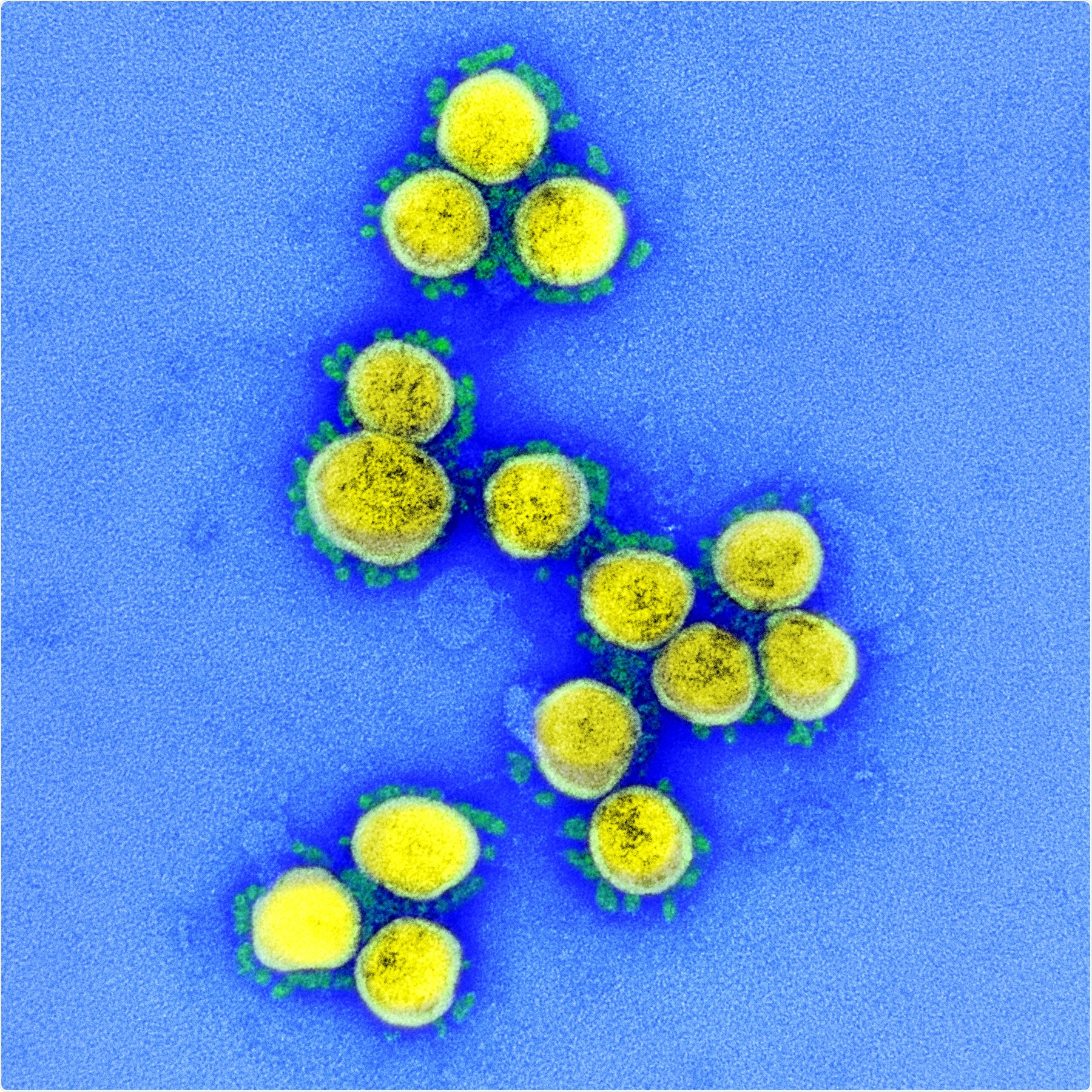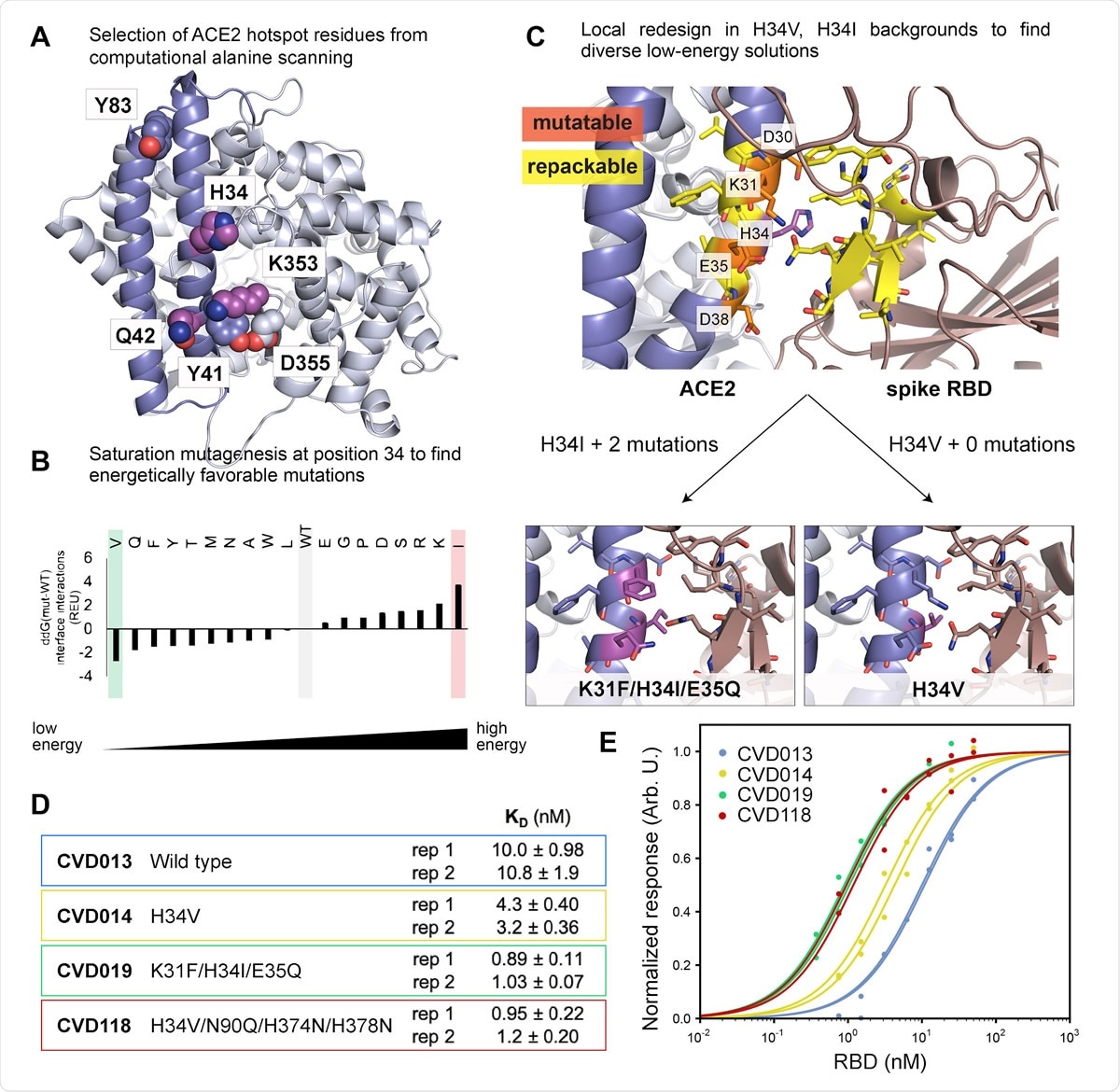Researchers in the United States and Canada have engineered affinity-optimized “receptor traps” that prevent severe acute respiratory syndrome coronavirus 2 (SARS-CoV-2) from binding to and infecting cells.
For SARS-CoV-2 to infect human cells and cause coronavirus disease 2019 (COVID-19), the viral spike protein must first attach to the receptor-binding domain (RBD) of the host membrane receptor angiotensin-converting enzyme 2 (ACE2).

Novel Coronavirus SARS-CoV-2 Transmission electron micrograph of SARS-CoV-2 virus particles, isolated from a patient. Image captured and color-enhanced at the NIAID Integrated Research Facility (IRF) in Fort Detrick, Maryland. Credit: NIAID

 This news article was a review of a preliminary scientific report that had not undergone peer-review at the time of publication. Since its initial publication, the scientific report has now been peer reviewed and accepted for publication in a Scientific Journal. Links to the preliminary and peer-reviewed reports are available in the Sources section at the bottom of this article. View Sources
This news article was a review of a preliminary scientific report that had not undergone peer-review at the time of publication. Since its initial publication, the scientific report has now been peer reviewed and accepted for publication in a Scientific Journal. Links to the preliminary and peer-reviewed reports are available in the Sources section at the bottom of this article. View Sources
Now, James A. Wells (University of California, San Francisco) and colleagues at the University of Alberta and Rockefeller University have developed variants of the ACE2 extracellular domain that stop this spike protein from binding ACE2 and entering host cells.
“Engineered ACE2 receptor traps offer a promising route to fighting infections by SARS-CoV-2 and other ACE2-utilizing coronaviruses, with the key advantage that viral resistance would also likely impair viral entry,” writes the team.
The researchers say the traps can be predesigned for viruses with known host cell receptors to provide fast therapeutic responses, without neutralizing antibodies needing to be isolated from patients who have recovered from infection.
A pre-print version of the paper is available in the server bioRxiv*, while the article undergoes peer review.
Many research teams have focused on neutralizing antibodies
Following infection with SARS-CoV-2, most of the neutralizing antibodies generated prevented the virus from entering cells by binding to the RBD on ACE2.
Given the urgent need for effective treatments during the current COVID-19 pandemic, many researchers have focused on ways to generate recombinant antibodies that can block this viral entry.
Both these engineered antibodies and those isolated from the blood of recovered patients have proved effective treatment approaches in previous pandemics.
However, such strategies require a significant proportion of the population to have developed protective antibodies following infection and recovery, which takes up precious time as the pandemic continues to sweep the globe.
Protein engineering approaches may offer a “rapid alternative”
“Protein engineering approaches to identify binders to viral entry proteins offer a rapid alternative, without the prerequisite for an infected population,” said Wells and colleagues.
Furthermore, escape mutations that the virus may develop can stop antibody treatments being effective. At the same time, mutations that decrease the efficacy of ACE2 receptor traps would probably also impair viral invasion, adds the team.
However, to date, there are no FDA-approved receptor traps available for use as antiviral biologics, although some are being tested in clinical trials as an HIV treatment.
What did the researchers do?
Now, Glasgow and colleagues have applied a stepwise protein engineering approach to develop inactivated soluble variants of the ACE2 extracellular domain that potently blocks the binding of the SARS-CoV-2 spike protein.
First, the team applied computational approaches to design an ACE2-RBD interface that would improve affinity for the RBD by up to 12 times.
Next, using a yeast surface display, the researchers discovered additional mutations that led to a 14-fold greater binding affinity for the RBD, compared with the computationally designed “parent” receptor trap.
The variant with the highest affinity bound to the RBD with 170 times greater affinity than wild type ACE2, reports the team.

Computational design of ACE2 for improved binding affinity to the spike RBD. (A) Computational alanine scanning identified ACE2 hotspot residues (shown as spheres) that contribute strongly to binding the spike RBD. Residues 18-90 are shown in blue and residues 91-614 are shown in light blue. H34, Q42 and K353, shown as magenta spheres, were selected for computational saturation mutagenesis. (B) Computational saturation mutagenesis predicted several stabilizing mutations to H34. H34V and H34I were selected for further design to generate diverse ACE2 receptor trap models. (C) Flexible backbone design was performed around V34 ACE2 and I34 ACE2 (WT residue H34 shown in magenta). ACE2 residues that were permitted to change amino acid identity (“mutable” residues) are labeled and shown in orange; ACE2 and RBD residues that were allowed to change rotameric conformations and/or backbone atom positions (“repackable” residues) are shown in yellow. Design around H34I resulted in two additional mutations, shown in magenta. (D-E) In vitro BLI measurements
Improving the binding affinity of receptor traps even further
Glasgow and colleagues say the affinity of engineered receptor traps is often improved through fusion to the constant (Fc) domain of human-engineered immunoglobulin.
The researchers report that adding the natural collectrin domain of ACE2 and fusing with the Fc domain of human immunoglobulin G yielded the most affinity-optimized receptor trap.
This receptor trap effectively neutralized both SARS-CoV-2 pseudotyped lentivirus and authentic SARS-CoV2, with viral replication reduced to almost undetectable levels.
A “promising route” to combating SARS-CoV-2
The researchers say the ACE2 receptor traps they engineered offer a “promising route” to combating SARS-CoV-2
“Engineered ACE2 receptor traps present key advantages in treating SARS-CoV-2 infections,” writes the team. “This approach has the potential advantage that viral resistance to an ACE2 receptor trap would also inhibit the ability of the virus to enter via binding to the ACE2 entry receptor.”
Furthermore, such traps could be used to target other emerging variant strains that use ACE2 as an access point.
The team also points out that a small research group achieved the affinity-optimization approach in just several months, similar to the time it takes to isolate antibodies from convalescent patients or through selection using in vitro methods.
“Thus, it represents a rapid and orthogonal approach to generating therapeutic candidates for treating future viral pandemics, without any prerequisite for an infected human population,” concludes the team.
Apparently improving upon the #JosefPenninger #rhACE2 approach: "Engineered ACE2 receptor traps potently neutralize SARS-CoV-2" by Anum Glasgow, Jeff Glasgow, Daniel Limonta, University of California, August 1, 2020: https://t.co/iJtJ9U2Gr2
Where does one get an engineered ACE-2 receptor trap? There could be a joke in this somewhere #COVID19 @UCal https://t.co/0TzEratAWJ

 This news article was a review of a preliminary scientific report that had not undergone peer-review at the time of publication. Since its initial publication, the scientific report has now been peer reviewed and accepted for publication in a Scientific Journal. Links to the preliminary and peer-reviewed reports are available in the Sources section at the bottom of this article. View Sources
This news article was a review of a preliminary scientific report that had not undergone peer-review at the time of publication. Since its initial publication, the scientific report has now been peer reviewed and accepted for publication in a Scientific Journal. Links to the preliminary and peer-reviewed reports are available in the Sources section at the bottom of this article. View Sources
Journal references:
- Preliminary scientific report.
Well J, et al. Engineered ACE2 receptor traps potently neutralize SARS-CoV-2. bioRxiv, 2020. doi: https://doi.org/10.1101/2020.07.31.231746
- Peer reviewed and published scientific report.
Glasgow, Anum, Jeff Glasgow, Daniel Limonta, Paige Solomon, Irene Lui, Yang Zhang, Matthew A. Nix, et al. 2020. “Engineered ACE2 Receptor Traps Potently Neutralize SARS-CoV-2.” Proceedings of the National Academy of Sciences 117 (45): 28046–55. https://doi.org/10.1073/pnas.2016093117. https://www.pnas.org/doi/full/10.1073/pnas.2016093117.